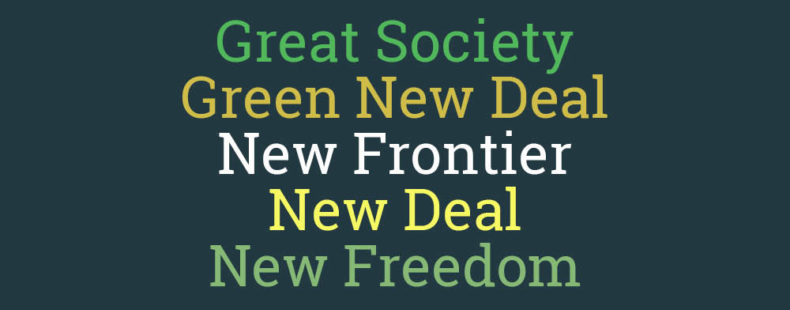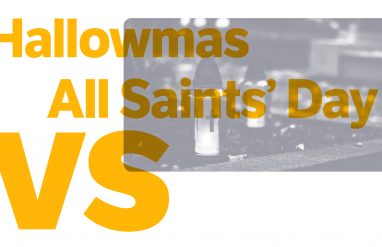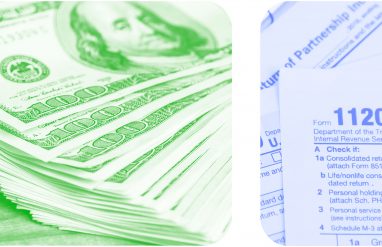What Makes A Policy Program Name Stick?
by John M. Cunningham
In the 1910s there was Woodrow Wilson’s New Freedom. The 1960s brought us Lyndon B. Johnson’s Great Society. And now, with the help of Senator Ed Markey and Representative Alexandria Ocasio-Cortez, the Green New Deal has become the talk of the Beltway.
Since the early 20th century, presidents and other politicians in the United States have used simple slogans to brand their domestic policy visions, but not all of these names have lodged themselves in the minds of Americans. Although the Green New Deal itself is having trouble taking off legislatively, the name has caught on like wildfire.
If the success of a political program is at least partly dependent on what it’s called, what does it take for a name like the Green New Deal to stand out?
Why did they choose Green New Deal for the name?
The name Green New Deal became attached to actual legislation in February 2019, when Markey and Ocasio-Cortez introduced a congressional resolution to create the Green New Deal as a federal program. The resolution failed to advance in the Senate in March 2019, leaving its future, as such, uncertain.
Just over a week before the resolution was rolled out, Ocasio-Cortez admitted in an interview that Green New Deal had been a placeholder name for a policy vision that she developed during her historic 2018 campaign: “I wasn’t 1,000 percent sure on that kind of branding,” she said, “but it kept like leaking and catching, and people just started writing articles calling it a Green New Deal ….”
…and we have #GreenNewDeal lift-off! 🌎🚀
Never underestimate the power of public imagination. pic.twitter.com/h4PqqPucEX
— Alexandria Ocasio-Cortez (@AOC) December 14, 2018
When did presidents start naming deals?
Once the The Green New Deal became associated with a major US political party, it was easy to view it as part of the storied lineage of American political programs with slogan-like names.
It all started with Roosevelt …
The trend is generally considered to have begun with President Theodore Roosevelt, who characterized his efforts to settle a 1902 coal miners’ strike as securing a “square deal” for both business and labor, among other usages around that time. By 1903, Roosevelt began using Square Deal as a shorthand for his overall domestic policy and the programs that resulted from it.
Then came the introduction of new, great, and fair …
Recognizing the political potency of such names, later presidents came up with their own. Woodrow Wilson had the New Freedom, a series of economic reforms aimed at increasing opportunities for small business in an era of growing corporate power.
Franklin D. Roosevelt’s New Deal promised a sweeping set of innovative solutions to the Great Depression, leading to such institutions as the Federal Deposit Insurance Corporation and Social Security.
After World War II, Harry Truman took on a domestic agenda called the Fair Deal, which included expanding social security, raising the minimum wage, and other initiatives to promote equality.
John F. Kennedy introduced the New Frontier to signal his commitment to explore “uncharted areas of science and space” and to address “unsolved problems of peace and war.”
And his successor, Lyndon B. Johnson, launched social-welfare programs (e.g., Medicare) and advanced civil rights (e.g., Civil Rights Act of 1964) under the banner of the Great Society.
The emergence of these names reflects the changing role of government and the US presidency in the 20th century. Before Theodore Roosevelt, presidents typically did not seek to exert significant influence over domestic policy. Their role was mostly to administer the laws that Congress passed.
As the 20th century wore on, however, the federal government expanded to meet the needs of a rapidly growing US population and support the country’s elevated status on the world stage. The executive branch added new departments, and presidents came to rely on ever more advisors, often drawn from elite institutions, to help them manage the complexities of the job.
Within this context, there was more room for domestic policy to be made directly from the White House. Not only that, but a robust domestic agenda could be part of a president’s pitch to the American people, as well as an opportunity to cement a presidential legacy with a signature achievement.
Branding for success
With the rise of the advertising age, presidents understood that a catchy name for a political program was a key to its potential success. Names such as New Freedom and New Frontier combined familiar American values with the bold promise of progress.
Deals, meanwhile, reinforced the egalitarianism at the heart of the American dream and the notion of a social contract between the government and the governed. (This contract later became explicit in the Contract with America devised by Newt Gingrich and other congressional Republicans in the 1990s.) For many Americans of the New Deal era, the name also evoked the phrase’s origin in card games, with similar connotations of a fresh start and fair play.
By the 1960s, the popularity of the names led to jokes such as one told by Michigan Gov. George Romney: “There was the New Deal of Franklin Roosevelt, the Fair Deal of Harry Truman, and now the Ordeal of Lyndon Johnson.”
As Romney’s quip implies, not all Americans were won over by these branding statements. In 1966, libertarian historian Clarence Carson wrote that their “pleasing associations” were smokescreens for what he considered the radical socialist nature of the programs themselves: “The phrases take established values and use them as the basis for the building of a new order.”
After the 1960s, however, such names mostly failed to take root. Few people recall the New Covenant (Bill Clinton), the Ownership Society (George W. Bush), or the New Foundation (Barack Obama), all of which landed with a thud despite their repeated—and some would say overdetermined—use in speeches.
Green New Deal is older than we thought
The rapid “liftoff” of Green New Deal might lead some to believe it’s a new coinage, but the term is older than you might think. One of the earliest references to a Green New Deal can be found in a 1994 proposal by the British Labour Party’s Policy Commission on the Environment promoting “greener” technology.
Around the 2007–08 global financial crisis, a number of economists, journalists, activists, and leaders around the world variously argued for their own versions of a Green New Deal to stimulate the economy through bold environmental policies. United Nations Secretary General Ban Ki-Moon, for instance, advocated for a Green New Deal in a 2008 speech, envisioned as a “massive global stimulus” that “fights climate change, creates millions of green jobs, and spurs green growth.”
Despite this seeming groundswell, the Green New Deal branding did not immediately capture the broad public imagination. While the concept has surfaced in the platforms of green political parties around the world—it was a centerpiece of US Green Party candidate Jill Stein’s 2012 and 2016 presidential campaigns, as well as the party’s bid for New York governor by Howie Hawkins in 2010—it did not become a major plank of more mainstream parties.
In 2018, however, the Green New Deal, as we now know it, was promoted by Ocasio-Cortez and several other young Democrats to push the party to commit to bold action on climate change. The effort gained media attention, and support for the Green New Deal quickly become a litmus test for progressive Democrats.
New Deal familiarity: A blessing or curse?
Perhaps Ocasio-Cortez was smart, then, to recognize the organic appeal of the name Green New Deal and not cast about for alternatives. The word green has been synonymous with the environmental movement since the 1970s; the color also represents renewal, growth, and progress more generally.
The invocation of Roosevelt’s New Deal, meanwhile, is a clever reminder of another ambitious government program that is widely perceived to have succeeded in solving an unprecedented crisis (the Great Depression). Rather than a bloodless, consultant-driven formulation, the name is full of gauzy historical resonance. The reference may also assuage fears about its novelty, as if to say “We’ve done this before.”
The name is not without its detractors, though. For some, the New Deal of FDR calls to mind a set of policies that did little to address racial inequality in the United States and, in some cases, made it worse.
Others are critical of the name on the grounds of political pragmatism. They argue that some politicians are so reflexively opposed to environmental protection and government spending that a proposal that foregrounds those ideas in its name is too toxic for them to even consider. As the director of a “conservative clean energy” organization puts it: “The Green New Deal is not an ideal name if you want to attract bipartisan support.”
Those concerns notwithstanding, it is remarkable how quickly the name has caught on with the public since it was taken up by Ocasio-Cortez and her supporters. Regardless of its legislative fate, the words Green New Deal seem likely to remain a potent symbol and rallying cry for advocates of large-scale action on climate change.
John M. Cunningham is a writer based in Chicago. For more than a decade, he worked at Encyclopaedia Britannica, where he served as its first Readers’ Editor and wrote articles on topics such as Justin Bieber and the National Spelling Bee. He is also a published crossword-puzzle constructor and a cocktail aficionado.














